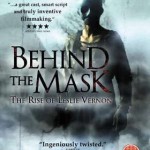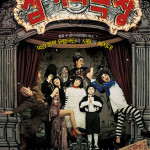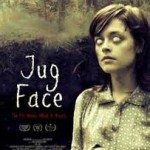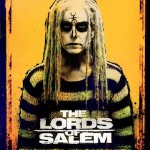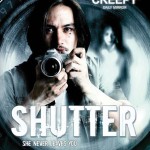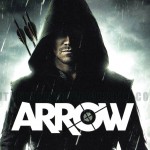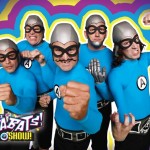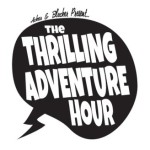
I feel like I came a bit late to The Thrilling Adventure Hour party. I had heard of the show, or at least that there was a show, for about a year. What I hadn’t heard was what it was about. Back in January when I went to the see the Welcome to Night Vale live show, it was announced that they would be back in Seattle in March for Emerald City Comicon, and to do a cross-over with The Thrilling Adventure Hour. So with that announcement I decided it was time that I find out what The Thrilling Adventure Hour was all about.
And once I did, I was more excited about them coming to town then Welcome to Night Vale.
In short, The Thrilling Adventure Hour is a monthly live show performed at the Largo at the Coronet, a 250 seat theater in Hollywood. It is a show done in the style of old time radio, with the performers standing on stage with scripts in hand and with sound effects added live. Segments of the show are then released weekly, as a podcast by Nerdist Industries.
The show was created in 2005 by Ben Acker and Ben Blacker, when they were developing an animated show to pitch. They liked how the read through sounded, and it inspired them to attempt the old style radio format. A typical live show is broken into three segments, two regular ones and a rotating middle segment. The segments are often broken up by ads for fictitious product brands.
So, from this basic format what was it that made me get really excited about this show? The simple answer would be everything, so let’s get down to specifics.
First is the writing; Acker and Blacker are amazingly talented writers, who found a format that lets them cut loose. The scripts are well plotted and paced with an emphasis on the dialog between characters. Also, you can clearly tell the characters apart just by the dialog, which comes in handy when different actors sometimes have to step in to play an already established character.
On top of that you have an embarrassment of riches in the actors.
The core performers of The Thrilling Adventure Hour are known as the Workjuice Players. They were formed initially from improv actors associated with Second City, and grew to include some of the regular guest stars. The current roster of the Workjuice players is Paget Brewster, Craig Cackowski, John DiMaggio, John Ennis, Mark Gagliardi, Marc Evan Jackson, Hal Lublin, Joshua Malina, Busy Philipps, Autumn Reeser, Annie Savage, Paul F. Tomkins, and James Urbaniak. Additionally, you have the show’s director Aaron Ginsburg, and Musical Director Andy Paley.
On top of the core players, the show has had an amazing array of guest performers. Nathan Fillion has appeared so often he has his own reoccurring segment. His Castle co-star Molly Quinn also has a reoccurring character. It would be insane to try and cover all the other guest stars, but examples include Weird Al Yankovich, Jon Hamm, Zachary Levi, Karen Gillian, and Clark Gregg.
Part of what attracts such notable guests is that the format requires no memorization, so prep time is minimal. Guest starring on the show has become such a big deal that many of the Workjuice players have said they are glad they got in early, as they are not famous enough to warrant a guest spot now.
It is a formula that works. The monthly live show regularly sells out. And they have regular attendees, as well as people coming to see the show after listening to the podcast. The live nature gives it an energy you just can’t get in a recording booth.
As for the show itself, you can tell that the fans are fully invested because they cheer loudly when familiar segments start.
And about those segments. They cover a wide range of genres, with the unifying factor of almost all of them being funny.
And what are those segments?
The live show traditionally starts with Sparks Nevada, Marshal on Mars. This was the original show that Acker and Blacker were writing as an animated pilot. It is literally a space western, telling the story of Sparks Nevada (Marc Even Jackson), a man from Earth in the 31st century who is the Marshal on Mars. He is aided by Martian native Croach the Tracker (Mark Gagliardi) who accompanies him to fulfill an onus owed to Nevada by his people. This is the one segment that is serialized and needs to be listened to in release order to follow the story. It also has several spin off segments that fit into its continuity, but I’ll get to them in a bit.
The last segment in the live show is Beyond Belief. This follows the adventures of Frank and Sadie Doyle (Paul F. Tompkins and Paget Brewster), a couple who get involved in various supernatural situations. They are pastiches of Nick and Nora Charles from the Thin Man movies. As such they are drinking constantly, and would prefer to be left alone, but always end up helping whoever comes to them for help.
The middle segments of the show rotate each month.
First you have what has become known as the “Sparks Nevada extended universe.” These are stories set in the Sparks Nevada continuity but do not usually feature Sparks himself. The most common of these is Cactoid Jim, King of the Martian Frontier featuring Nathan Fillion as the title character, a cross between Davy Crockett and Buck Rogers.
Next is The Adventures of Captain Laserbeam, starring John DiMaggio as a Silver Age style superhero. In later episodes it also features Phillip Fathom, Deep Sea Detective (Hal Lublin), who is basically an aquatic version of the Nolan Batman.
Down in Moonshine Holler follows the exploits of a depression era millionaire (Craig Cackowski) who abandons his old life to become a Hobo, as he searches for his love The Hobo Princess.
The Cross-Time Adventures of Colonel Tick-Tock features a Victorian gentleman (Craig Cackowski) who protects the timeline on behalf of Queen Victoria. It has a spin off in The Algonquin Four, where members of the Algonquin Round Table gain the powers of the Fantastic Four.
Tangentially related to Tick-Tock is Amelia Earhart, Fearless Flyer, where the famed pilot faked her disappearance in order to fight time traveling Nazis across history.
The show also has a completed series called Tales from the Black Lagoon, featuring Mark Gagliardi as Ben Chapman, the actor who played the Creature from the Black Lagoon. The story is a Noir alternate history of Hollywood, and the only segment to not play up comedy.
There are also various one or two shot segments that occur from time to time.
All segments, with the occasional exception, are narrated by Hal Lublin.
One of the strengths of the show is that it avoids the common comedy trope of the hero being an incompetent idiot who wins through the luck that comes from the efforts of others. Rather, it mines its comedy from dialog, relationships, and the situations the characters find themselves in.
An example is Sparks Nevada, who is very blasé about everything and a bit egotistical. However, in a crisis his blasé attitude translates into a lack of panic, and his ego gives him confidence in his skills. The humor is usually about his relationship with Croach, or their mutual love interest The Red Plains Rider (Busy Phillips) and how issues involving these come up at the worst possible times.
I give The Thrilling Adventure Hour a grade of A-. Genre fans will love it and non-fans should enjoy most of it. The only reason it gets the minus is not everyone will enjoy every single segment.
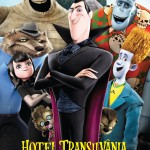 Hotel Transylvania is a deviation from our normal Halloween reviews in that it is not a horror movie, but a comedy using horror tropes. However, I expect it to become a Halloween movie staple in the years to come.
Hotel Transylvania is a deviation from our normal Halloween reviews in that it is not a horror movie, but a comedy using horror tropes. However, I expect it to become a Halloween movie staple in the years to come.

